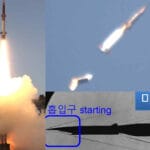At DSEI 2025 in London, the CTA International consortium—formed by Nexter (KNDS France) and BAE Systems—highlighted the expanding role of its CTA 40 Case Telescoped Armament System (CTAS) across both manned and unmanned turret architectures. With growing adoption across NATO-aligned forces and integration into a widening array of platforms—from infantry fighting vehicles to naval remote weapon stations—the CTA 40 is reshaping medium-caliber lethality through compact design and modular adaptability.
Case Telescoped Ammunition: Compact Power with Strategic Implications
The core innovation behind the CTA 40 system lies in its use of case telescoped ammunition (CTA), where the projectile is embedded within the propellant casing. This design reduces cartridge length by up to 33% compared to conventional rounds of similar caliber (e.g., NATO-standard 35×228 mm), enabling more compact feed systems and higher onboard ammunition capacity.
The CTA 40 fires a family of specialized munitions including:
- Armour Piercing Fin Stabilized Discarding Sabot – Tracer (APFSDS-T)
- General Purpose Round (GPR-PD-T) with programmable fuzing
- Airburst GPR-AB-T for anti-personnel or drone threats
This ammunition suite allows engagement of a broad target set—light armor, infantry in cover, low-flying UAVs—with precision effects. The reduced recoil impulse also facilitates integration into lighter platforms without compromising structural integrity.
Modular Turret Integration Across Domains
At DSEI 2025, multiple turret solutions built around the CTA 40 were on display—demonstrating its flexibility across crewed and autonomous configurations. Key systems included:
Nexter T40 Manned Turret
The T40 turret integrates the CTAS with advanced optronics from Safran and Thales. Designed for IFVs like the French EBRC Jaguar or export variants such as VBCI upgrades, it supports dual-axis stabilization, hunter-killer targeting modes, and secondary armaments including ATGMs (e.g., MMP or Spike).
Nexter ARX-40 Unmanned Turret
This remote weapon station variant incorporates the same gun system but in a fully unmanned configuration suitable for light armored vehicles or robotic ground systems. Its reduced silhouette enhances survivability while maintaining full lethality via EO/IR sensors and optional radar cueing.
Naval Adaptations: CTAi Naval Mounts
BAE Systems has adapted the CTAS into stabilized naval mounts under development for OPVs or corvettes requiring medium-caliber punch without large deck penetration. These mounts offer improved counter-UAV capability in littoral environments where traditional CIWS may be overkill or cost-prohibitive.
Operational Uptake Among NATO Forces
The CTA 40 has already been fielded on France’s EBRC Jaguar reconnaissance vehicle under the SCORPION program—a key modernization effort aimed at digitizing French Army formations. The UK’s Ajax program also selected the CTAS for its Ares reconnaissance variant after extensive trials under MoD oversight.
Additional interest has emerged from export customers seeking to upgrade legacy BMP-2/3 fleets with modern firepower while retaining mobility. The compactness of CTAS turrets makes them attractive retrofit candidates where internal volume constraints exist.
Advantages Over Conventional Medium-Caliber Systems
The primary advantages offered by CTAS over traditional chain guns like Bushmaster III (35 mm) or Rheinmetall MK30-2/ABM include:
- Reduced volume footprint: enabling smaller turrets or more internal space for electronics/ammo
- Straight-line feed path: simplifies autoloader design; fewer mechanical failure points
- Ammunition commonality: same round types usable across land/naval platforms with minimal modification
A potential drawback remains cost per round—CTAs are generally more expensive than conventional brass-cased munitions—but proponents argue that increased hit probability offsets this through lower expenditure per effect achieved.
DSEI Demonstrations Emphasize Interoperability & Digital Architecture
A recurring theme at DSEI was digital integration. The T40 turret showcased full compatibility with NATO Generic Vehicle Architecture (NGVA), allowing plug-and-play sensor fusion with battle management systems (BMS). This enables real-time sharing of target data between manned/unmanned assets—a critical enabler for multi-domain operations.
The ARX-40 demonstrated remote operation via secure datalink from an offboard command post—underscoring its suitability for optionally crewed vehicles or UGVs operating in high-risk zones such as urban terrain or contested crossings.
Future Roadmap and Ongoing Development Challenges
Nexter and BAE Systems continue to refine both ammunition types (including potential proximity-fuzed airburst variants) and fire control software enhancements to improve first-round hit probability against fast-moving aerial targets such as loitering munitions.
A key challenge remains ensuring long-term affordability amid constrained defense budgets. While initial procurement costs are higher than legacy autocannons, lifecycle cost modeling suggests savings through reduced platform wear-and-tear due to lower recoil forces—and potentially fewer rounds fired per kill due to improved accuracy.
Conclusion: A Mature Yet Evolving Medium-Caliber Solution
The CTA International consortium has positioned the CTA 40 not just as a gun system but as an adaptable lethality module compatible with modern C4ISR networks across land and sea domains. As NATO forces prioritize modularity, digitalization, and counter-UAV capability in future force structures, weapons like CTAS will likely see expanded deployment beyond their original IFV niche—into robotic platforms, light strike vehicles, patrol vessels, and even hybrid air defense roles.








